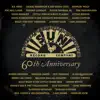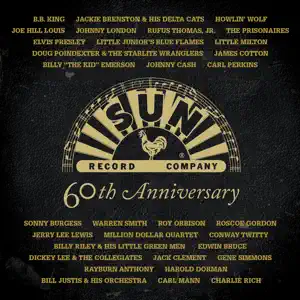


Acerca de The Teen Kings
It seems difficult to believe at this late date, but there is a chapter in the musical life of the late Roy Orbison that's hardly ever been mentioned or discussed -- an eight-year musical relationship that yielded recordings and newspaper recognition, at least in Wink and Denton, TX, and numerous radio and television appearances, as well as getting him notice by Sam Phillips and signed to Sun Records. That chapter was the Teen Kings, Orbison's first musical outlet and his first attempt at doing something that might matter in music. Indeed, the Teen Kings' history predates the birth of rock & roll -- much less Orbison's aspirations to stardom in that field -- by more than five years.nnThe Teen Kings' roots go back to 1948, two years after his family moved to Wink, TX, when the 12-year-old Orbison began playing guitar with a friend and schoolmate named James Morrow. The following year, the two put together a quintet -- Morrow on electric mandolin, Orbison on lead guitar, Charles "Slob" Evans on upright bass, Richard "Head" West at the piano, and Billy Pat "Spider" Ellis on drums. At a teacher's suggestion, they christened themselves the Wink Westerners, and they played school dances and other small local events. Within two years, they were good enough to get some radio appearances, and by 1953 they had their own sponsored show on KERB once each week. The Wink Westerners played country & western, and their repertory included lots of instrumentals, among them "In the Mood" and "Little Brown Jug." They were popular at local dances, presenting a lively show that the kids appreciated, and at the center of it was Roy Orbison, who was not only a strong singer but a talented lead guitarist. He didn't yet have the operatic depth to his singing that would make him internationally famous a decade later, but he could wail out a ballad or rip through a dance number like nobody's business. The group's radio show, as was the case with most performers in those days, was barely a break-even affair financially, but it served well as a promotional medium to get them the performing gigs. They also appeared on the KERB Jamboree with other local bands, again doing country & western material. The group was good enough to impress their high school principal, who got them a performance at a Lion's Club convention in Chicago. By 1954, they were also backing up players like Slim Whitman. Orbison and Ellis attended North Texas State College in Denton, and the group held together during this period, sufficiently long enough to discover rock & roll by the end of 1954. Around that time, they'd even added "Shake, Rattle & Roll" to their repertory. It was while at North Texas State that Orbison first encountered a fellow fraternity member, Wade Lee Moore, who had co-authored a song called "The Ooby Dooby" with Dick Penner. The Wink Westerners later auditioned for Columbia Records using the latter song, to no avail. Following a brief hiatus, the Wink Westerners resumed their activities during the summer of 1955, and managed to get an appearance on a television show on KMID-TV in Midland, TX, doing country songs but also covering what was becoming increasingly familiar rock & roll material, including the current hit "Rock Around the Clock" by an ex-Western swing band, and "That's All Right" by that Elvis Presley fellow out of Memphis, and Moore and Penner's "Ooby Dooby." As the radio show had been, the television appearances were used mostly to promote the band's live appearances. The band had gotten very good, and doubly so in the context of local performing groups. Although he was no Scotty Moore (who could play anything), Orbison had become a formidable lead guitarist and singer, and the band matched him. The kids were also starting to dance more enthusiastically to R&B songs (what were called "rhythm numbers" in those days), and the group was performing more Little Richard, Bo Diddley, Chuck Berry, Elvis Presley, and Big Joe Turner than Hank Williams. A change in name was called for, and the Wink Westerners became the Teen Kings. The group had a few lineup shifts -- Orbison himself had to teach Evans' successor on bass, Jack Kennelly, how to play the instrument -- but kept playing and hoping for a break. Texas in those days was filled with hundreds, perhaps thousands of small bands that were evolving out of country music and into rock & roll. Buddy Holly was just getting into the music seriously around that time, and a lot of veteran country players were busy adapting their styles to the new music, or trying to. The Teen Kings were young enough that it wasn't a stretch, and the results were natural. Their break came with help from the father of a woman that James Morrow was dating. Having heard the group's radio broadcasts, and seen some shows and television spots, he arranged for a recording session at Norman Petty's studio in Clovis, NM, which yielded a pair of songs, "Trying to Get to You," which had been a single by an R&B vocal group called the Eagles, and had been covered (but not yet released) by Elvis Presley, and "Ooby Dooby." They were issued on two sides of a single (45 and 78 rpm) in early 1956 on the Je-Wel label. The songs were played by a record store owner friend of the band in Odessa TX, over the telephone to Sam Phillips of Sun Records. By the end of March, the band was under contract to Sun and playing gigs with Johnny Cash. The Sun single of "Ooby Dooby" had a different B-side,"Go! Go! Go!" Ironically, the original B-side of Je-Wel, "Trying to Get to You," went through a bizarre odyssey of its own -- Weldon Rogers had also recorded the song, and the Teen Kings' version was sent to Lew Chudd at Imperial Records by mistake, along with Rogers' rendition and the song "So Long, Good Luck, and Goodbye" -- the Teen Kings' version accidentally ended up on the B-side of the latter single by Rogers, and was "lost" and forgotten in the Imperial catalog for the next 36 years, until it was licensed for inclusion on Sony Music Special Products' 1991 box set The Legendary Roy Orbison. The Teen Kings' "Ooby Dooby" (which already credited Orbison more than the rest of the group) peaked at number 59 nationally, and their next single, "You're My Baby" b/w "Rockhouse," again credited to Orbison and the Teen Kings, failed to chart nationally. Sam Phillips' strategy was becoming clear -- he'd pegged Orbison for stardom, and the other group members came to resent this, not only in the billing on their records but, ultimately, the structure of the recording sessions. The end came when they turned up for a recording session and saw that Phillips had booked in additional musicians to work with Orbison. His success at Sun ended with "Ooby Dooby," and it would take another half-decade for another label and producer, Fred Foster (ironically, the producer of the Eagles' original version of "Trying to Get to You") at Monument Records, to help Orbison achieve the level of success that Phillips saw in his potential. The Teen Kings only left behind a handful of Sun and Je-Wel tracks, but in 1995, a group of 16 live recordings from KOSA-TV in Odessa in 1956 were unearthed and released for the first time by Rollercoaster Records. Featuring the last incarnation of the band, it's a special body of work for a variety of reasons, presenting Orbison at the peak of his early rockabilly period, and also a rare chance to hear live-in-the-studio performances by an early Sun act, with no producer getting in between the artists and their music, or the public and appreciating it. ~ Bruce Eder
Discografía de The Teen Kings
3 discos

Pretend
2019

The Teen Kings Lost and Found
2015

Pretend
2014
Canciones más vistas de
The Teen Kings en Enero
Top Artistas
Nosotros
Notas
